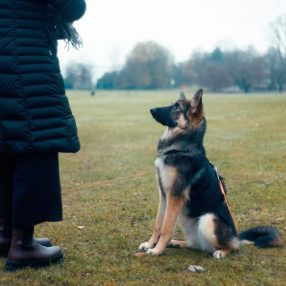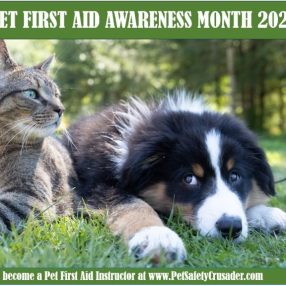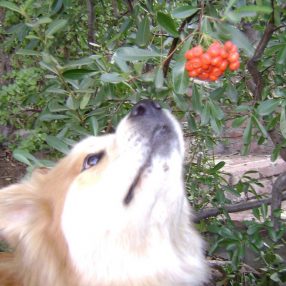Veterinarians are the experts, but most of us are not lucky enough to have a Vet velcroed to our hip 24/7, and even if you live with 5 people in your house, odds are that when the dog stops breathing or cuts his paw…you will be home alone and it will be after veterinary hours. Therefore Pet Parents must know how to jump to the task to rescue Rover before professional medical help is available! In addition to knowing the life-saving skills of Pet First Aid and having the confidence to use them, anyone who spends time around pets must have a well-equipped tool kit (aka your Dog’s First Aid Kit) as precious time can be wasted looking for the right item once a pet has suffered sudden injury or illness. I always say that a kit is only as good as the human at the other end of the leash, meaning – if you use something up, replace it; if it expires, get another, and take special care of items that can go bad, especially if you keep your first aid kit in the car or other area subject to extreme temperature changes. Besides medications and creams, even the stickiness of various wraps and tapes can degrade due to heat, and Hydrogen Peroxide does not hold up if it gets warm, so be prepared to keep these items cool or change them out regularly.
In addition however to learning Pet First Aid & CPCR (yes, there is now a second “C” standing for “cerebral”) and having a Pet First Aid Kit, there are five specific things you can do to get on the path to becoming a better pet parent:
- Know the location of your nearest Animal Emergency Center.
Some locations are open 24/7 while others open at 6pm and close 8:00 the next morning to fill that gap of time when your Veterinarian is closed. Drive there before you need to, so that if you suddenly have an emergency, you aren’t wondering if it’s a right turn or a left turn or which side of the street help is on. Also find out what services are offered (anti-venin for snake bites, blood for transfusions, MRIs, etc.) and how payment is accepted. Doing your homework can alleviate stress when your pet needs you most.
- Keep up with annual veterinary visits.
Although you may not need to visit the Veterinarian annually for vaccinations (check into titer testing — blood testing that determines immunity to specific disease), it is still of prime importance that you allow those professional eyes, hands, ears, stethoscope, blood test and urinalysis confirm that your pet is okay. Determining a slight decrease in kidney function for instance, can allow for changes to the diet, an increase in exercise or other modifications at the earliest signs rather than waiting for symptoms to present themselves meaning a problem already exists. Think of your Veterinarian as your pet’s second best friend (you should be #1), and work as a team for the life of your dog.
- Do a weekly Head-to-Tail Check-up of your pet and pay attention to normal habits.
Really get to know your pet, his body and his habits. The better you know what is normal for Fido, the more quickly you can determine when something is not quite right signaling you to get him professional medical assistance. Start slowly getting him used to your touch (which also makes him a better patient at the groomer and the Vet) and learn the idiosyncrasies of his body. Know what is supposed to be there (yes, male dogs also have nipples, those aren’t ticks!) and what is not…lumps, bumps, foxtails & burrs, fleas & ticks for instance. Notice what your dog looks like when he sits and stands. Does he moan when he gets up off the floor or sit with a leg cocked to the side? Arthritis or hip dysplasia could be making life difficult. How often do you have to fill his water bowl and how often does he need to answer nature’s call? An increase or decrease in any of these activities could mean something in his body is changing and warrants a veterinary check-up.
- Read your pet’s food label.
Ingredients on the can and bag are listed in diminishing order meaning the first 3-5 items listed are the bulk of your pet’s diet. Make sure the first ingredient is a high quality protein — the name of the animal in the bag or in the can (ie: chicken, lamb, salmon, sardines, venison or turkey). The term “poultry” can mean less-desirable portions of various birds are included in the food and what in the heck is a “meat?” I personally have never seen one roaming on a range! Limit or refrain from grains altogether…wheat, corn and soy cause allergic reactions in many pets. Can’t pronounce it? Then your dog probably doesn’t need it as well as color and flavoring additives which can be carcinogenic.
One of the best gifts you can give your dog is to educate yourself on canine nutrition. Canine bodies cannot safely metabolize all the same foods ours can, and while they may eat a small woodland creature (bones, gristle and fat) without issue, once bones are cooked, thy splinter and cooked fat turns to grease resulting pancreatitis for your dog.
Although many fruits and vegetables can be beneficial to animals, choose wisely: grapes and raisins can cause kidney failure, macadamia nuts can lead to paralysis, seeds from peaches and plums contain an arsenic-like substance and onions can break down red blood cells causing hemolytic anemia in pets, not to mention the caffeine-like substance known as theobromine found in chocolate. Know what must remain out of paws reach. Both the Humane Society of the United States and the ASPCA post good lists of what can poison your pet. Even with the safe veggies though (green beans, carrots and spinach for example), realize that dogs have shorter intestinal tracts than we do, so food sits in the stomach longer but doesn’t have has much time to break down in the colon, especially the cellulose (plant fiber) inherent to vegetables. To help your dog get the most from his veggies, steam them lightly, chop very fine or puree for best absorbency. Learn and become an advocate for your pet when shopping or making his meals.
- Spend quality time together.
I whole-heartedly feel that the most important tip for becoming a better pet parent is this…spend good quality time daily with your dog. That’s why we have pets – to make them part of the family, so be sure to give your furry kid your undivided attention several times daily. When you go for a walk – pay attention to him! Don’t talk on your cell phone or be sending text messages. Be in the now and live in the moment like your dog does. Couple that with providing exercise, fresh air (it does a body good – canine or human) and continue his obedience training to keep him safe and you’ll be worthy of the unconditional love your best friend gives so selflessly!
Please also read my Pet Parenting 101 blog for even more tips… http://www.petsafetycrusader.com/pet-parenting-101/
Also watch my VLOG on this topic at https://youtu.be/Ko4vSxMG2c0
____________________________________________________________________________________
Denise Fleck is an award winning author and freelance writer. After extensive training, practice, more training and more practice, she developed her own Pet First-Aid & CPR curriculum and has been teaching animal life-saving skills for close to 20 years with many success stories to share. Additionally she developed a 5 month long Animal Care course for high school students in conjunction with the Burbank Unified School District and Animal Shelter. She has demonstrated animal life-saving skills on CBS –TV’s “The Doctors,” Animal Planet’s “Pit Boss,” “Kirstie Alley’s Big Life” and countless other shows. To complement her teachings, Denise created a line of Pet First-Aid Kits, posters and books for children teaching animal respect and care! Visit www.PetSafetyCrusader.com or call (818) 951-7962.
Note: The articles on this page are copyrighted. Please do not reprint or use portions for any purpose without written permission from the author. Request permission for usage by sending an email explaining how you’d like to use the materials and what parts specifically. Thank you in advance!










